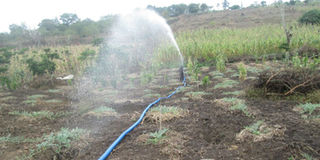‘Appropriate technologies are increasingly popular with farmers’

A sweet potato farmer places vines that he multiplies for other farmers in a screen house. End-user preferences are important to consider in selecting and breeding sweet potato varieties. PHOTO BY FRED MUZAALE
What you need to know:
Over time, farmers in Uganda are recognising the fact they need mechanisation and the use of technologies such as irrigation in their operations. Stephen Otage caught up with Victor Kazimiri, an engineer at Davis and Shirtliff to explain how farmers are embracing farm technology.
Irrigation is one of the technologies that Many farmers consider to keep their crops productive even during dry seasons. What about farmers who have livestock and poultry?
Contrary to that common perception about irrigation, the livestock and poultry farmers can have irrigation systems on their farms too.
For instance, we have farmers who bought systems to irrigate grass for cattle especially farmers from Western Uganda. Birds depend a lot on water so they buy solar water pumping systems because the farms are located in areas without electricity. What is important is to invest in technology which takes water as close as possible to the farm.
What have you done to make your technologies affordable to farmers?
We have designed irrigation kits which we think can be affordable to rural farmers. These are have foot operated manual pumps with hosepipes ranging between 10 and 50 meters. Our proposal is to install a central solar system to pump water to different locations for manual irrigation.
What are some of the equipment?
We deal in solar products like solar installations to power homes, solar water heaters and solar water pumps which I must say, have contributed greatly to our business growth because of irrigation. We sell these under the pumps division. They include drip, sprinkler, fixed and movable irrigation systems.
We have sprinkler systems such as one of a 35-meter- radius which can move to different points. This is the cheapest because it cuts costs.
For instance where it would require you to spend Shs.20 million to irrigate five- acres, it will cost you Shs. 4 million and farmers have purchased huge numbers of these units. Farmers refer each other to us and this has contributed towards business growth as far as we are concerned. Daily we receive 10 inquiries about irrigation as a segment.
We also have rain guns which can irrigate an acre in one rotation of 20 minutes. This one costs between Shs. 1.3 million and Shs.3.5million for systems per acre, but you must have a raised water reservoir tank and means of delivering the water to the raised ground.
You require a water source and a pump and since most farms are located in places where there is no electricity, we use solar pump.
Let us talk about their cost, are the prices not prohibitive?
Our solar pumps start from as low as Shs800,000 depending on the client requirements. We have pumps for domestic use which fetch about 500 liters of water per hour but it is not appropriate for irrigation which need engine pumps to pump 2,000 liters of water per hour and this one will cost you about Shs20m.
Are farmers buying this one?
In the long run, you are saving a lot. I have had a client who had 1,000 cows in his farm. He came here and I gave the options of an electric pump and the solar system. He chose a pump and generator after 8 months he returned it for a swap with a solar pump because he needed huge volumes of water every day to irrigate his grass in the farm and provide water to the animals. I accepted the electric pump back and fortunately I sold it off that very month. I always tell the farmers that they are not buying these pumps for one season. They can recover the cost just within the first season which makes returns on the investment. We work as professionals. We do not stop at selling the pumps but we do installations because these are specialized equipment. We advise about installations, we quote, in other words you hire us to do a complete job.
Where do most of your clients come from?
They range from individuals to government institutions, Ministries and NGOs but most irrigation systems are being sold to government ministries, parastatals, NGOs and UN agencies especially the Food Agriculture Organization who are doing a lot of small scale irrigation in Kotido and Moroto areas. We also sell a lot to Eastern and Northern Uganda where there is often drought. We do a lot of work with NARO and we are looking at ways of cutting the costs as much as possible to ensure that every farmer can afford our products because we often get many inquiries but not many show up because many come thinking the kits are cheap but they disappear because they think the systems are expensive.
What is your advice to farmers?
We have made proposals to the office of the prime minister and they are consulting with Ministries of Agriculture and environment for feasibility studies. We are concerned about the Karamoja region and hilly places. We have the systems depending on client needs. What limits them is the funding. Government is doing a lot of work with contractors. We have boreholes which are transferring water as far as 28 kilometers away. We have the systems and we prefer selling them as fixed systems so as to cut costs.




